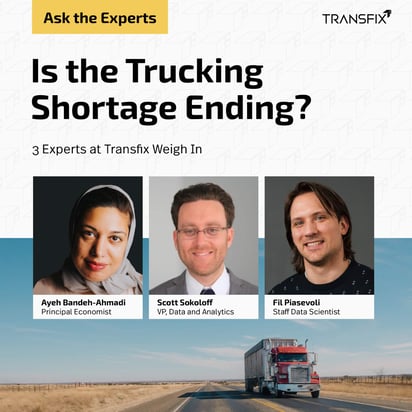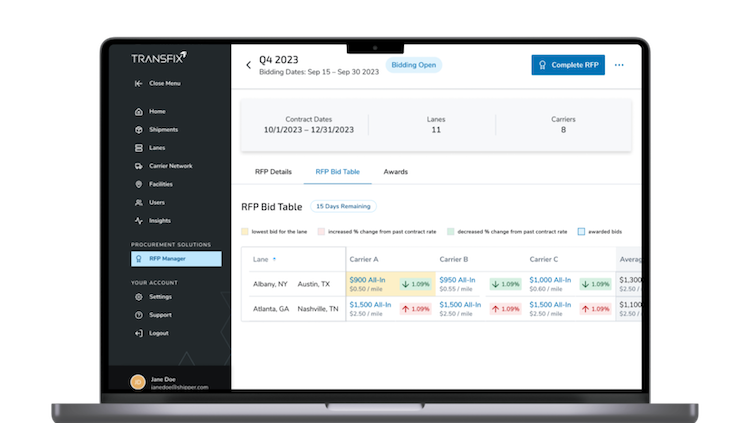3 Experts at Transfix Weigh In

At Transfix, we’re always monitoring the shifts and swings of the market. We asked Ayeh Bandeh-Ahmadi (Principal Economist), Scott Sokoloff (VP of Data and Analytics), and Fil Piasevoli, (Staff Data Scientist) to share their thoughts on where we are and what we could be headed towards. Read where each of them stands, below.
Ayeh Bandeh-Ahmadi (Principal Economist, Transfix)
We’ve definitely seen shipping prices ease over the last couple months, which our models had predicted earlier than the rest of the market– so we priced that drop in early and benefited from more contract business. We’re seeing that fall hit in other carriers’ contract prices, too (the HBR article describes contract prices rising), as carriers seem to be feeling the spot crunch– and rushed to lock in much lower rates than they were previously willing to look at.
HBR mentions that the easing of the port backlog in L.A./Long Beach may be a sign of slowing of the demand pipeline for trucks. This was partly a result of Chinese lockdowns, which have now reversed and are sending backlogs rising at US ports from Los Angeles– where they are just now surpassing 2021 volumes during the same week– to Long Beach and the East Coast, where port officials in NY and Savannah are noting rising congestion.
When West Coast ports started backing up consistently, logistics companies began diverting loads to other US ports. New York and New Jersey harbors had been seeing higher backlogs even before Shanghai reopened from lockdowns for this reason.
The other real question is how much higher driver wages will stick, given tightening economic conditions and Fed rate rises. Yes, trucking wages have been behind in keeping up with inflation over the past 30 years, but current wages are a result of the very heated market we had up ‘til the beginning of this year. The Fed is fighting inflation and wage rises; these get passed on to consumers in the form of higher final costs for goods and are one kind of inflation. So I absolutely don’t think we can take higher driver wages as a given. Ultimately, driver wages will also be a result of the overall job market nationally. If some drivers can respond to moderating wages by moving to non-trucking jobs (as we started seeing a little evidence of this month), then that will moderate the size of the driver base, keeping wages for remaining drivers from dropping as quickly. This is the situation we are in right now, with U.S. unemployment levels still at historic lows and more than one job available per job-seeker. But if, at some point in the Fed’s tightening cycle, we see the job market for workers become tougher, then that could remove the pressures supporting historically high trucker wages.
Scott Sokoloff (VP, Data and Analytics)
I’ll agree with everything Ayeh said and add in that– for the first time in many, many months– we are seeing natural seasonality return to the market. Produce season came in the middle of the market shift/drop in prices (being shown in the article). We are seeing signs that volume in certain markets are going up – though still at a somewhat muted tone, reflecting a net loosening of capacity.
I’d also add that Transfix Opinion has been that there’s not been a shortage of trucking capacity; it’s a by-product of poor overall planning and resource allocations. When you look at the number of empty miles on the road, it is far greater than the estimates for the number of driver miles that would be filled by the so-called shortage.
Fil Piasevoli (Staff Data Scientist, Transfix)
I think the term “trucking shortage” guides the conversation to only half of the equation behind the cost of moving goods, the other half being the amount of shipments needed to satisfy national consumer demand.Looking at data from the Bureau of Labor Statistics regarding seasonally-adjusted employment in the trucking sector, one would see that supply recovered to pre-March 2020 levels as early as June 2021, with December employment eclipsing the all-time high previously set in June 2019. Each month since June 2021 to now has seen employment in the trucking sector set a new all-time high. In this manner, describing the recent state as a “trucking shortage” puts an unfair amount of blame on the carrier side of the equation.
As we know, the pandemic changed consumer behavior in innumerable ways, and while the rising amount of consumer dollars going into disposable goods lifted many ships (and corporate profits!), I don’t think these shippers adapted quickly enough to this changing landscape. Increased consumer demand has led to a one-to-one increase in the amount of freight needing to be moved over the road. Rather than thinking outside the box about how to modify the supply chain for a different market, we saw truckloads piled onto an already-shaky system. Truck drivers flocked to answer the call of freight to be moved, causing their ranks to swell to all-time highs, as mentioned before. The changes we’re experiencing in the market today are not the result of a trucker shortage being satisfied. Rather, the levels of shipper activity are returning to pre-pandemic levels, with smaller or unprepared carriers being the most likely to bear the brunt of this market adjustment– as reduction of freight is most likely to leave them on the outside looking in.




